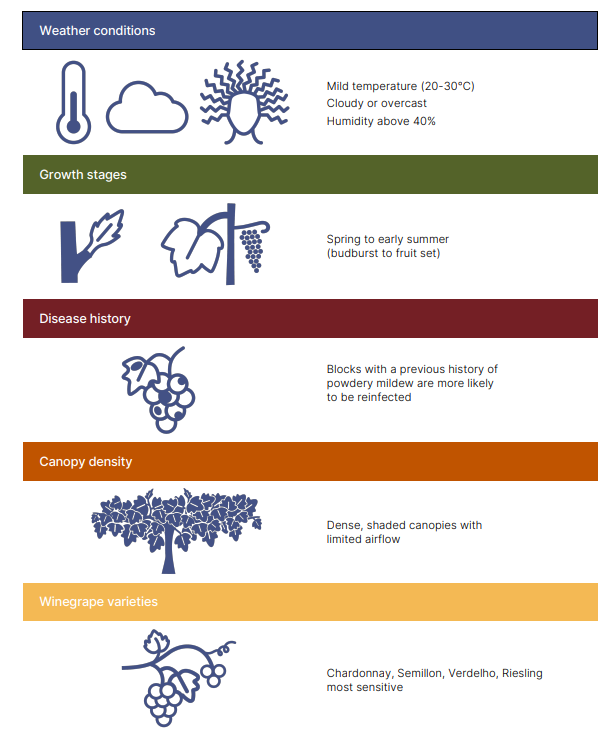24 October 2025
Fungicide resistance in powdery mildew puts both crop quality and costs at risk this season and beyond.
This eBulletin outlines why powdery mildew fungicide resistance is a problem, how to recognise, test for, and manage it.
About powdery mildew
Powdery mildew is one of the most important diseases of grapevines in Australia. The disease is caused by the fungus Erysiphe necator, which affects green grapevine tissue. When the following set of conditions arise, powdery mildew can become a problem:

What is fungicide resistance in powdery mildew and why does it matter?
Powdery mildew can develop resistance to fungicides when the fungus Erysiphe necator changes genetically over time, making fungicides less effective or even ineffective at controlling it.
Fungicide resistance is a problem for winegrape growers because it can lead to:
- fewer effective tools to manage the disease;
- the need for more frequent or varied fungicide applications;
- environmental issues;
- negative public opinion;
- higher production costs;
- greater crop losses; and
- possible fruit rejection.
Read more about how fungicide resistance occurs and how to avoid it in this new fact sheet here.
How do you know if you have resistance to powdery mildew fungicides?
If you are applying fungicides each year and the incidence and severity of powdery mildew in your vineyard seems to be getting worse, you may have fungicide resistance or reduced sensitivity.
Powdery mildew fungicide resistance detections in Australian vineyards
Recent research led by South Australian Research and Development Institute (SARDI), a research division of the Department of Primary Industries and Regions (PIRSA), has confirmed the detection of powdery mildew fungicide resistance to several fungicide groups commonly used in vineyards.
| Active ingredient | Fungicide Activity Group | Resistance status |
| difenoconazole | 3 | Not detected |
| penconazole | 3 | Detected |
| tetraconazole | 3 | Not detected |
| spiroxamine | 5 | Not detected |
| boscalid | 7 | Not detected |
| pydiflumetofen | 7 | Not detected |
| azoxystrobin | 11 | Detected |
| pyraclostrobin | 11 | Detected |
| proquinazid | 13 | Detected |
| quinoxyfen | 13 | Detected |
| pyriofenone | 50 (U8) | Not detected |
Source: South Australian Research and Development Institute (SARDI)
While only one representative formulation per active ingredient was evaluated as part of this research, a range of registered products for each of the above active ingredients can be found in Table 2 of the 2025/26 Agrochemicals registered for use in Australian viticulture, commonly known as the ‘Dog book’. A full list of detections from this research can be found on page 18 in the 2025/26 ‘Dog book’.
How can you test for powdery mildew resistance?
If you suspect you may have fungicide resistance in powdery mildew, a free national testing service to monitor fungicide resistance in powdery mildew, downy mildew and botrytis in winegrapes is available (until June 2027).
Samples for powdery mildew resistance testing can be submitted to the SARDI Horticulture Pathology Laboratory by following the detailed sampling instructions here. Biosecurity considerations apply. Prior to sending samples to the laboratory, please contact ismail.ismail@sa.gov.au.
This testing service is part of a research project led by SARDI in collaboration with Curtin University and the AWRI, and funded by Wine Australia, the Cooperative Research Centre for Solving Antimicrobial Resistance in Agribusiness, Food, and Environments (SAAFE CRC), SARDI and Curtin University.
Importance of spray program management
Overuse of the same fungicide groups as part of a spray program is a key contributor to the development of powdery mildew fungicide resistance.
One of the key information sources provided annually in the ‘Dog book’ to assist you in reducing powdery mildew fungicide resistance is the CropLife Australia resistance management strategy on page 17.
Before you order your chemical products for the new season, review this strategy alongside your proposed spray program. In particular, take note:
- of the fungicide group associated with each product you plan to apply;
- that all powdery mildew fungicide groups must be applied preventatively before disease is present;
- of which fungicide groups must be applied as part of a co-formulation or tank-mixed with an alternative fungicide group when applied consecutively – Groups 7 and 11;
- that some fungicide groups (e.g., Group 11) exhibit cross-resistance among their members, meaning that changing the product or active ingredient within the same group does not contribute to effective resistance management;
- of the suggested maximum number of times each fungicide group be applied in the season; and
- of whether the fungicide group can be applied as a consecutive spray in the program – Groups 3, 5, 13, 19, 21, 50 (U8) and U6.
Note that some fungicide groups and/or products are restricted or prohibited from use by some wineries or grape suppliers. Refer to Table 2 in the ‘Dog book’ and your winery/grape purchaser’s guidelines before you spray.
In addition to reading the CropLife Australia resistance management strategies, always read chemical labels prior to spray application, to ensure you are applying the correct treatment rate.
Further information
The AWRI is currently developing a new guide for powdery mildew management. Look out for it in an upcoming eBulletin.
Currently available resources on powdery mildew and fungicide resistance include:
- Agrochemicals registered for use in Australian viticulture, the ‘Dog book’
- AWRI helpdesk – call 08 8313 6600, or email helpdesk@awri.com.au.
Acknowledgements
The fungicide resistance testing work has been supported by the SAAFE CRC whose activities are funded by the Australian Government’s Cooperative Research Centre Programme.
The AWRI thanks Mark Sosnowski and Ismail Ismail from SARDI and Lincoln Harper and Fran Lopez Ruiz from Curtin University for their review.
This eBulletin is supported by Wine Australia with levies from Australia’s grapegrowers and winemakers and matching funds from the Australian Government. AWRI is a member of the Wine Innovation Cluster in Adelaide, SA.


